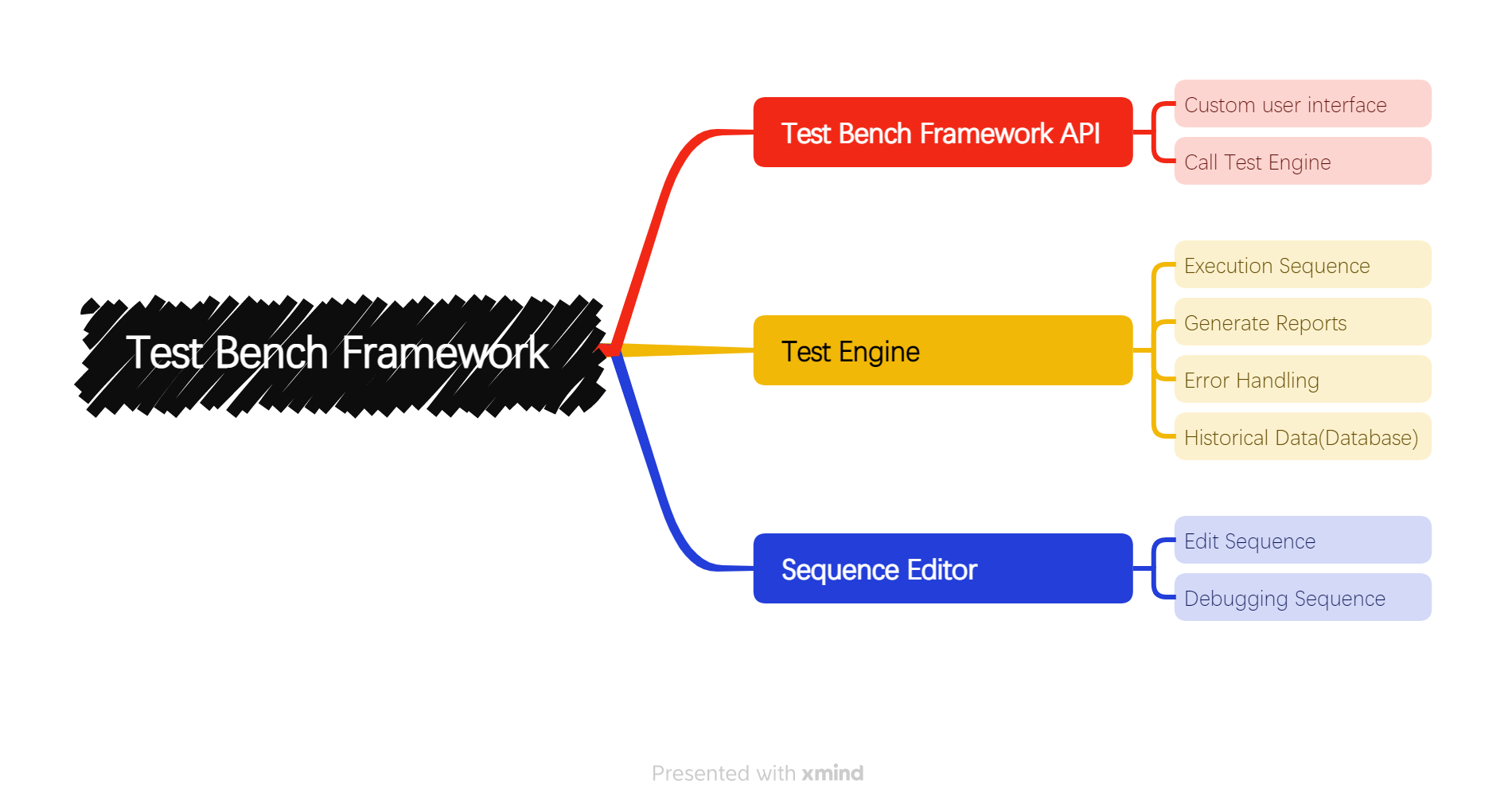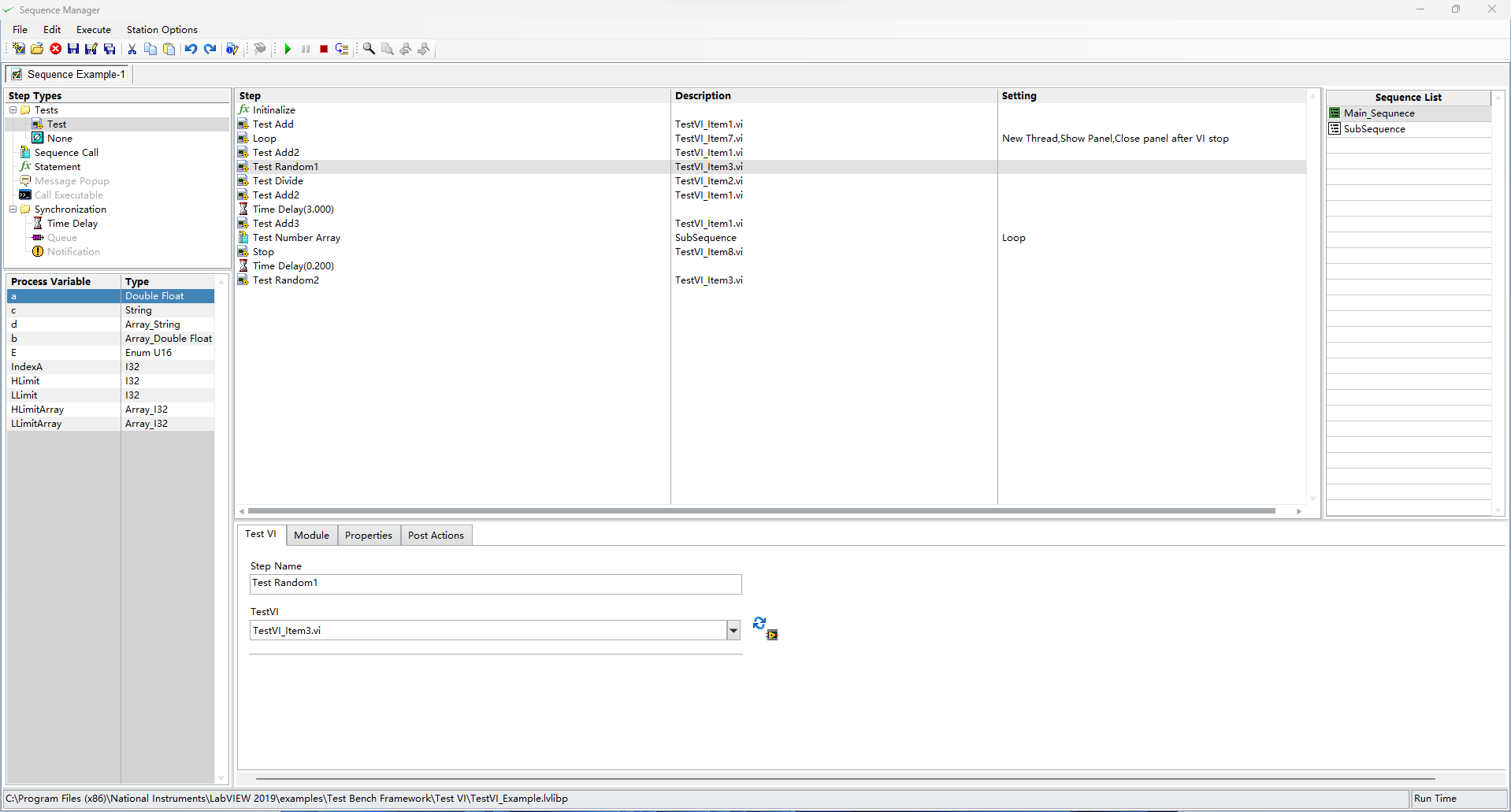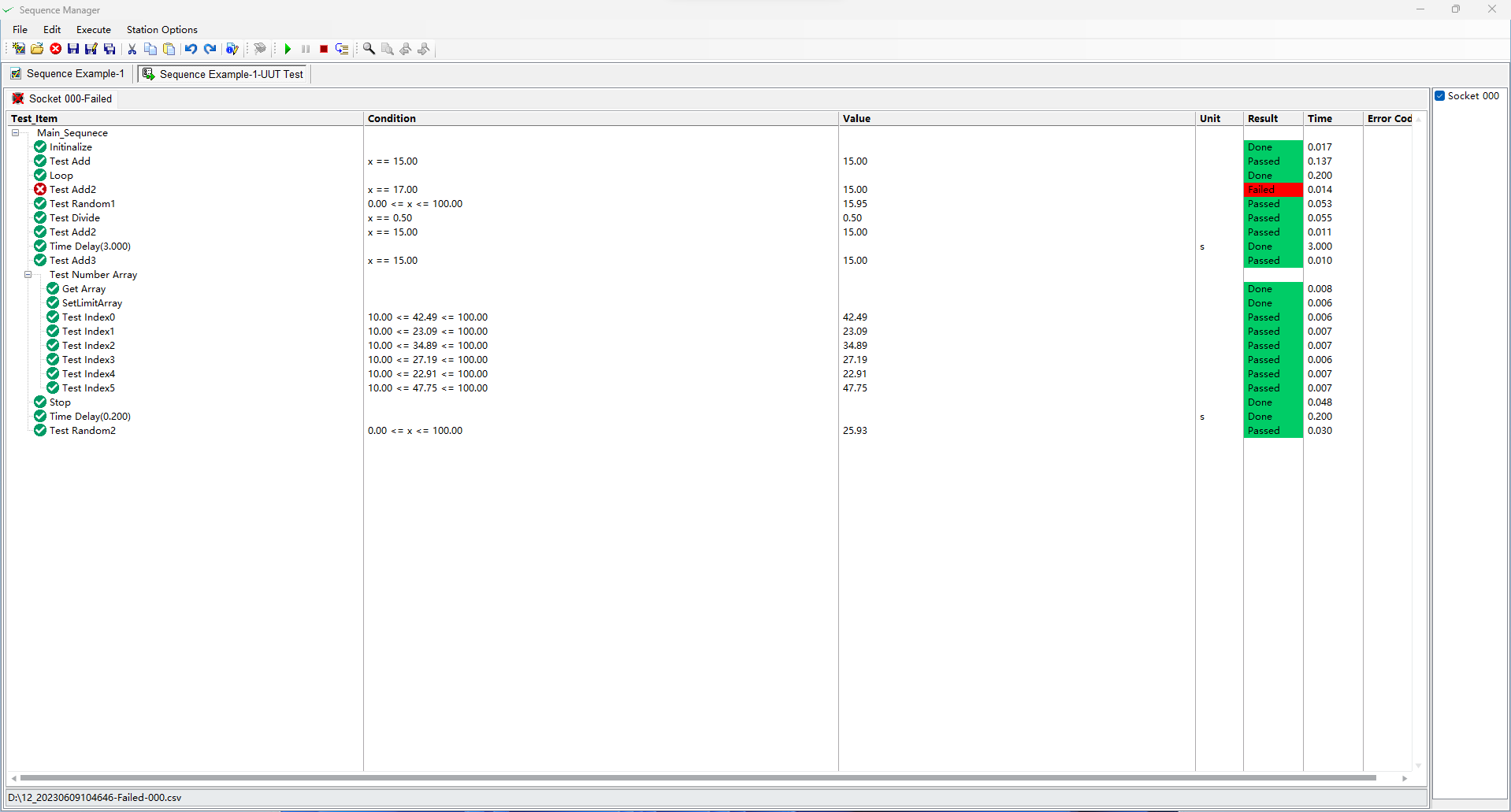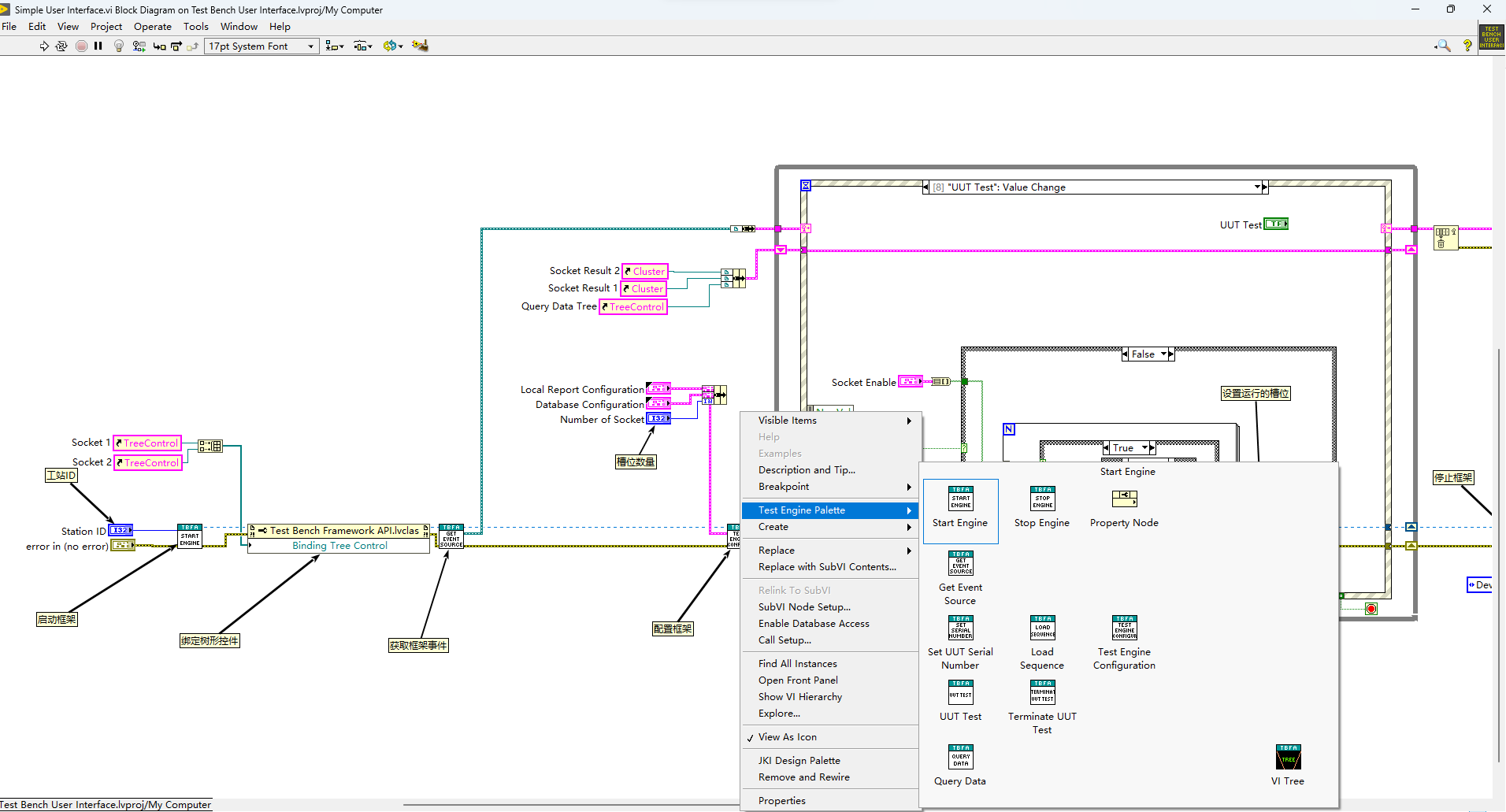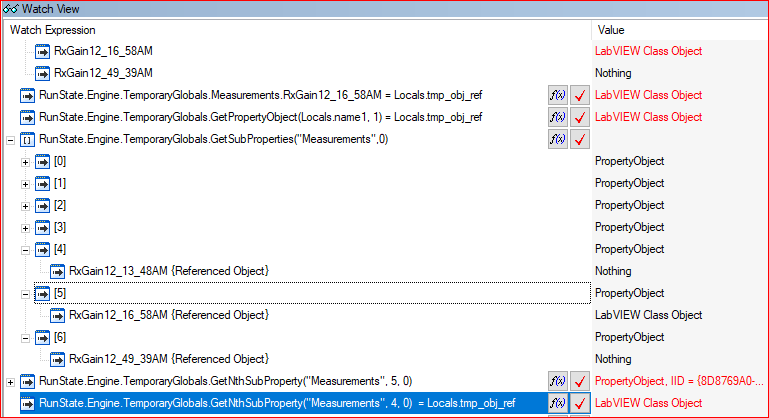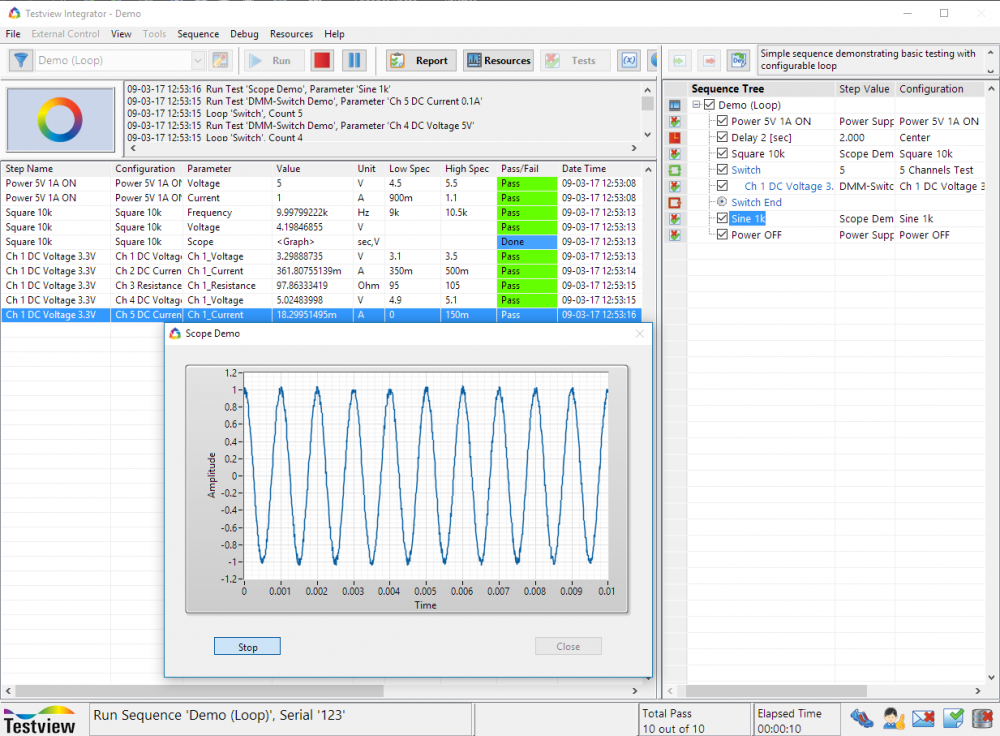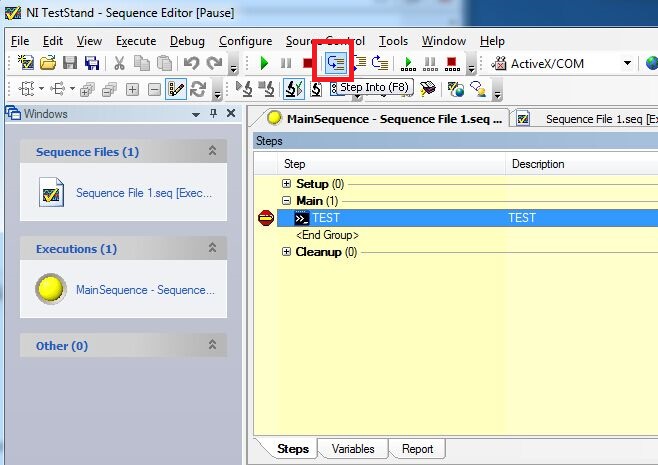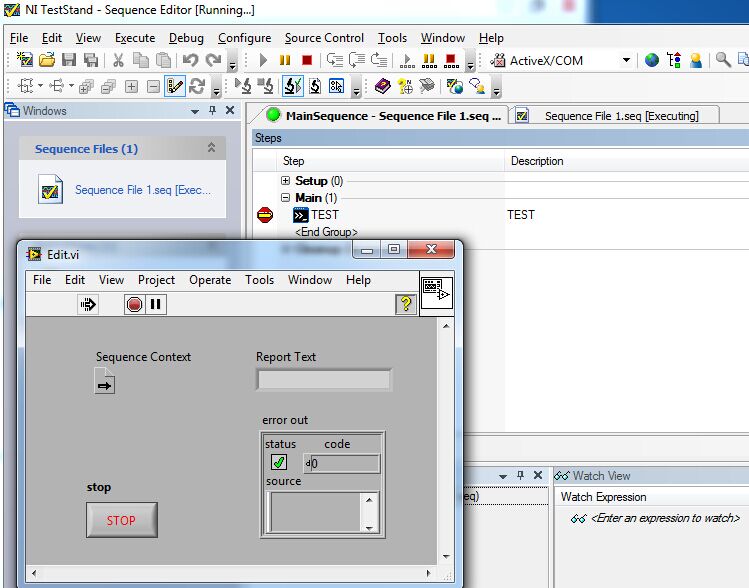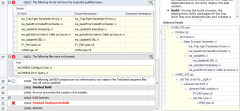Search the Community
Showing results for tags 'teststand'.
-
I used LabVIEW to develop a toolkit for ATE software. The toolkit is called "Test bench Framework", which includes a test sequence editor and a test engine.This toolkit features the ability to execute several different sequences in parallel.If you are interested in this kit please contact me, thank you! This toolkit is over 10MB in file size and cannot be published on VIPM, so I uploaded it to Github.Test-Bench-Framework . I used the TestStand icon inside my own sequence editor and wondered if there would be any copyright issues involved.But it's not commercially available yet.
-
TestStand Version(s) Used: 2010 thru 2016 Windows (7 & 10) Database: MS SQL Server (v?) Note: The database connection I'm referring to is what's configured in "Configure > Result Processing", (or equivalent location in older versions). Based on some issues we've been having with nearly all of our TestStand-based production testers, I'm assuming that TestStand opens the configured database connection when the sequence is run, and maintains that same connection for all subsequent UUTs tested until the sequence is stopped/terminated/aborted. However, I'm not sure of this and would like someone to either confirm or correct this assumption. The problem we're having is that: Nearly all of our TestStand-based production testers have intermittently been losing their database connections - returning an error (usually after the PASS/FAIL banner). I'm not sure if it's a TestStand issue or an issue with the database itself. The operator - Seeing and only caring about whether it passed or failed, often ignores the error message and soldiers on, mostly ignoring every error message that pops up. Testers at the next higher assembly that look for a passed record of the sub assemblies' serial number in the database will now fail their test because they can't find a passed record of the serial number. We've tried communicating with the operators to either let us know when the error occurs, re-test the UUT, or restart TestStand (usually the option that works), but it's often forgotten or ignored. The operators do not stop the test sequence when they go home for the evening/weekend/etc. so, TestStand is normally left waiting for them to enter the next serial number of the device to test. I'm assuming that their connection to the database is still opened during this time. If so, it's almost as though MS SQL has been configured to terminate idle connections to it, or if something happens with the SQL Server - the connection hasn't been properly closed or re-established, etc. Our LabVIEW based testers don't appear to have this problem unless there really is an issue with the database server. The majority of these testers I believe open > write > close their database connections at the completion of a unit test. I'm currently looking into writing my own routine to be called in the "Log to Database" callback which will open > write > close the database connection. But, I wanted to check if anyone more knowledgeable had any insight before I spend time doing something that may have an easy fix. Thanks all!
-
Hello, I am trying to do the following (LabVIEW2019, TestStand2019, Windows 10) Create a new sub-property under RunState.Engine.TemporaryGlobals as Measurements.TestName_DateTimeStamp My TS expression: //get a handle to runstate.engine.temporaryglobals Locals.tmp_prop_object = RunState.Engine.TemporaryGlobals, //create a new obj ref type property under this Locals.tmp_prop_object.AsPropertyObject.NewSubProperty(Locals.name1, PropValType_Reference, False, "",0), where Locals.name1 is Measurements.TestName_DateTimeStamp (e.g: RunState.Engine.TemporaryGlobals.Measurements.RxGain12_16_58AM) I now want to assign a LabVIEW class object to this property as: RunState.Engine.TemporaryGlobals.Measurements.RxGain12_16_58AM = Locals.tmp_obj_ref where Locals.tmp_obj_ref is the output terminal of a LabVIEW class and tmp_obj_ref is a TestStand variable of type Object Reference If I do it like this in the expression window, I can see that my RunState.Engine.TemporaryGlobals.RxGain12_16_58AM has been assigned a LabVIEW class object However, the value RxGain12_16_58AM is known to me only at run-time, so I cannot hard-code the assignment expression as above. Any pointers on how to achieve this? Basically if, Locals.name = "RxGain12_16_58AM" (created at run-time) then i want to be able to assign, during run-time: RunState.Engine.TemporaryGlobals.RxGain12_16_58AM = Locals.tmp_obj_ref
-
Hi All, We are upgrading a big project with TestStand 2010 and LabVIEW2010 to version 2013 (TS and LV) Meanwhile upgrading a few items in the database and configuration. In teststand 2013 you can configure result processing options. We configured the database option to log in a MySQL DB. All works fine. However, it would be usefull to read the datalink configuration in the operator interface. Is there a way to read the >> Result processing >> Database >> Database options >> Data link >> connection string expression with the teststand api? I've been searching in the teststand engin api and the application manager api but so far no succes. Thx. Wim
- 1 reply
-
- result processing
- database connection string
-
(and 1 more)
Tagged with:
-
15. FIFTEEN. That's the number of current job postings in my group. We're hiring! This is the most fulfilling, challenging, and rewarding position I've held. Job specific requirements listed on the website. https://www.lockheedmartinjobs.com/search-jobs/Test%20Engineer/Grand%20Prairie%2C%20TX/694/1/4/6252001-4736286-4684904-4694482/32x74596/-96x99778/15/2
-
Bonjour, Je recherche pour une mission longue durée (1 an minimum) en région parisienne un(e) ingénieur(e) LabVIEW & TestStand expérimenté(e). Une certification CLD/CLA et/ou CTD serait fortement appréciée. Un backgroud en électronique/mécatronique serait un plus. Disponibilité ASAP Français obligatoire. Contactez-moi en MP ou par Mail
-
Hi all, We're excited to announce the public release of TVI – our industry-proven test management framework for LabVIEW: http://tvi.co TVI is a flexible and easy to use test sequencer and reports generator for LabVIEW based functional testers. Key features: Simple and easy to use user interface Very short learning curve Creating test sequences in few clicks Viewing results in real time Exporting of data in various formats (CSV, PDF, HTML) Seamless integration with LabVIEW enables to write/edit tests directly from TVI (developer mode) Editing sequences and test parameters on the assembly line stations (runner mode, no need for LabVIEW) (TVI does not require TestStand to run) See it in action here: https://youtu.be/7Job4qMc66w We’d love to get any feedback! Thanks, Avital
-
From the album: Can't access imgur
-
Hi There I want to go from TestStand's output i.e. database to HTML5 SPC charts. Sorta like http://moderndata.plot.ly/using-plotly-from-labview-via-python/ Has anyone done this or used Bokeh or Enthough's data tool before? What about these tools with TDMS or HDF5? Thanks. I appreciate it. Best, Pavan By the way, https://www.enthought.com/services/consulting/case-studies/TAIPAN/ (like TestStand without TestStand)
-
Hello Lava members, I'm trying to control a Keysight Spectrum Analyzer using an IVI driver within TestStand but until now without any success, I'm pretty lost... I already installed the IVI compliance package and configured NI-Max. How can I add a step type for a Spectrum Analyzer? Does anyone have a example of how to do this? (I also read something about code modules, but I don't understand...) It looks like I can control a Keysight Power Supply, there is a IVI Power Supply step type. With kind regards,
-
Hello Everyone, Im pretty new to TestStand, and have to modify a pretty extensive sequence, mainly, we only want to add a step at the end that will retrieve some information from preovius steps and put them in a txt file, this will be done easy using a step to cal a VI, the issue is that i cant retrieve the values i need. This is my MainSequence, this is where the UUT is being tested, i will only focus on 1 value, i want the result value from the 340nm Position Check step: This is my "TestReport" Sequence, it will run after the main sequence, i want to retrieve information in the GetTestResult VI, It seems that i cant get the right context or values, This is the main prototype of my VI I have tried using in step settings, the Context "in" as "RunState.SequenceFile.Data.Seq["MainSequence"]." and then in the lookup string tryied using "Main["340nm position check"].Trans_Red.Result" but it returned an empty string, it should be returning a string like "6.83458985222004". am i doing something wrong?, im attaching the seq file as reference, but not the VI. Thank you so much for your help. Edit1: clean up blank lines in the text. Sequence_Reflectometer_ModifiedForMES.seq
-
Hi All, Software: Teststand 2010 LabVIEW 2012 Target: I created a custom steptypes that including a Pre-step and a Edit-step.When I run teststand, I want to online debug Edit vi. Details: As picture program suspend,only when I click stepinto button,teststand invoke Edit-step vi, if I Invoke stepover button, teststand don't invoke Edit-step vi,just invoke pre-step VI. Can you give me some solution? Edit.vi Pre.vi Sequence File 1.seq
-
I work with a small-ish (5-6) team of developers at my company. We're trying to update and improve a lot of our old test station software and we've decided to try using TestStand for sequencing instead of writing a custom sequence for each test station and product, or trying to write a generic but highly complicated sequencer ourselves that could work for every test station we have. In order to keep things as modular as possible we'd like to come up with a set of rules/guidelines that we all agree to follow in some manner, so we can assign one person to develop for tests using one type of hardware, one for a different type of hardware, one to do all of the database interactions, and so on, but with the requirements and interactions for those clearly defined enough such that there's no unexpected interactions between VIs. We'd also probably need to put in place a few new coding guidelines, such as perhaps a ban on global variables, trying to cut down/eliminate passing clusters/objects between VIs and passing primitives instead, and so on. I'm just curious if there's anyone out there who has done something like this before and maybe has any advice for things to establish before getting started. It's much easier to do things as right as possible from the beginning instead of waiting until we have hundreds of VIs written in an inconvenient way and we have to make the decision whether to rewrite them all to be "right" or to work around them even though they are "wrong", etc. Thanks!
-
From the album: Can't access imgur
-
Hello all, My setup is so: Have a LV project calling the TS simple UI. TS then runs multiple UUTs with a modified model seq. When the Main LV program is started, it initializes my many global variables used in the program, the variables in question are queue references. Once the TS UI is up and running the program is automated and requires limited interaction. During the course of the main TS sequence, TS calls many VIs, some that use global variables to get a queue reference so a command can be added to a DAQ or CAN queue. My problem is that the global variables TS is trying to access never seem to get populated with the refnums that are created in my top level VI that is calling TS. I know my Main VI is populating those globals because I can drop that global on my main VI and monitor it the whole time the program is running. So why doesn't TS see the same globals that my Main VI does?
-
Hi everybody, After posting my problem on NI forum, I couldn't get any hints to achieve what I want to do. Here is my problem : I'm buiding a TS Operator interface which can display several distinct execution at the same time (modified // processmodel). Each is displayed in a specific ExecutionView in an independ window (TestSocket ExecView). Each ExecutionView is realted to its own ExecView Manager. I'd like to create a another window (Supervision window) which lists all running executions (within standard TS ListBar) and when I chose an execution from the ListBar it displays the corresponding execution (and related components : callstack, variables, etc...). So I'll have the same execution displayed into two different ExecutionView (each ExecutionView being related to its own executionView Manager). The problem is that each time I interact on the same execution (pausing, terminating, showing it), the execution is re-sent to my supervision ExecViewMgr. This seems to disconnect the TestSocket execView from the current execution. Do you know if it is possible to display the same execution in 2 different ExecutionView ? Does anybody achieved the same functionnality before ?
-
Senior Labview Developer (CLA or CLAD) Company is seeking a Senior Labview Developer with strong Hardware/Senior Hardware Engineer or Software/Senior Software Engineer experience. The candidate should also have experience with automotive automated test systems architecture and design. Company is a provider of electrical engineering design and consulting services to the automotive OEMs and Tier Suppliers. Our experience and expertise allows us to assist our partners with integrating their products into the OEM vehicle. Position Requirements: Coordination and management of all Tester Group related projects Supports Program Managers with tester development issues and customer negotiations Supports quote preparation/resource determination for a specific project Hands on experience in implementing automated test systems for electronic control modules Experienced in defining and validating component and system requirements for test equipment Ability to define project effort and task share and experienced in requirements management Strong programming skills in LabView Well familiar automotive software programming standards and processes such as CMMI and ISO 26262 Strong knowledge in communication networks such as CAN, LIN, FlexRay etc. Ability to understand and interpret strategy development criteria and application needs Strong vehicle electronic system background Professional communication skills to be able to present and interact with clients Organized project management skills Ability to mentor and coach other team members Qualifications: BSEE is required; MSEE is a plus 5 years of experience related to this position is required; 10 years of experience is a plus. In-depth knowledge of electronic control units and electro-mechanical control systems is required Practical experience using NI equipment and software packages (LabView, testStand, etc.) is required Effective project management, organizational, and teamwork skills are required In-depth knowledge of Microsoft Office Suite and MS Project is required Excellent verbal and written communication skills are required Highly motivated individuals with effective organizational skills and team working abilities are required Pay is commensurate with skills and qualifications of the applicant. We offer generous compensation packages including a 401k with profit sharing and a generous health plan. If you are interested you can email me at Arisi@techrg.com or call me at 248-546-6900 ext.15.
-
I am using TestStand 2010 so if this information is not correct for later version, please help me remove this topic. In TestStand, when there is a step does not run because of previous condition step like "If", the status of that step will be left as empty. This returns a clear visual affect, in debugging, that this step has not run. But if I have a condition step and another step under this condition. If in the first interval this step ran and in the second interval this step didn't run, it still keep the status from the first run interval.If I just put a break point at the begin of the loop and click play instead of go through each step, I will think that these step ran in the second interval. Should it be better if there is a flag or something indicates that this step did not run at all? Regards, Thang Nguyen
-
Hi, I have a big project to manage which includes :-TestStand + LabVIEW-SQL Database for test inputs (UUT characteristics, sequences parameters,...) -HTML Reports -almost 10000 different part numbers (that's THE point) with common characteristics (almost 3000 families) + specific characteristics Everything has to be imaginated. The SQL inputs tables have to be created. The number of sequences to code has to be reduced to the minimum because, of course, it's impossible to code 8000 sequences differents files... The final solution must be as simple as possible. Possible ways of reflexion : -XML and Xpath for families and their children -Intermediate LabVIEW OOP layer for families and their children -Dynamically created sequences + variables (TS scripting)-Dynamically created sequences (concatenating a bunch of generic sequences to build a specific sequence) There is a lot of documentation about TestStand and SQL, but only for results (outputs), not really about inputs. Does anybody manage this kind of project ? In which way ? What would be your advices ? Thanks, Sébastien CLA
-
Hi Lava, I'm having an issue with a teststand deployment (Teststand 2013, LabVIEW 2013) I have a deployment which deploys my LabVIEW project containing all drivers (classes and lvlibs) for use in my sequences. In the deployment (LabVIEW options), I uncheck "exclude vi.lib", "exclude user.lib" and "exclude instr.lib" because the deployment should also work on an PC that only has runtimes and an operator interface. The build finishes without errors but I cannot open the deployed project... --> not on a development PC because it finds conflicts (XNodeSupport and some vi's in vi.lib picture.llb) --> not on a runtime PC (file not found) Did anyone else notice the same behaviour ? Thanks in advance for your help, tips and tricks :-) At first, i thought i had something to do with LabVIEW search paths (because I include vi.lib, it should not search for the vi's in the real vi.lib) but that didn't help... http://lavag.org/topic/18620-labview-search-paths/#entry111920
-
Hi all, I need some help... You'll read 'TestStand' a few times but it is a LabVIEW problem In my current project I have 4 testsetups all running teststand sequences. The 4 PC's are connected to a network and there is 1 network printer. I need automatic printing of the teststand reports and I want to wait until printing has finished. I discovered that automatic report printing in teststand is not that easy (don't understand why but ...). I found a LabVIEW workaround here (and also asked my question there) I implemented this 'Action'in my sequential model and this works fine. So the VI opens the xml report in a webbrowser window and it prints. So far so good, but I would like that vi to wait until printing is finished or at least until it is successfully sent to the printer. I tried making another vi that reads the default printer queue via a .NET constructor node etc etc . I can see my printjob (because I now the useraccount that submitted the printjob). BUT ... the 4 testsetups are logged in with the same windows user account so I can't filter on submitter. Any ideas on how to implement this ? I attached the 2 vi's: TS Print Report.vi is the vi that opens the XML report and sends it to the printer. printertest.vi checks the local printerserver and reads the default printqueue and PrintJobInfoCollection. The VI's are in LabVIEW 2010 Thanks for our help. printertest.vi TS Print Report.vi
-
Northwest Contract Services is seeking a Sr. LabView Developer to assist our client, a game console manufacturer who is set to make a major announcment on May 21st, to perform the following responsibilities: 7+ years’ experience in Labview (Must have worked end-to-end Architecture/Design/Test) DLL development in Labview Minimum 5+ years’ experience in hardware test/design environment. Solid EE skills Hardware Test experience Experience using test equipment (multi-meters, o-scopes etc.) Experience with sensors a big plus Project management experience is a big plus .Net, ActiveX, Vision, Motion, DAQ, instrument communication, TCP/IP, source code control, state machines TestStand experience is a plus C++/C# experience is a plus Northwest Contract Services offers very competitive wages, a comprehensive Medical/Dental/Vision plan - 100% of premiums paid by NWCS , and a 4% Match 401K program. This opportunity is a long-term position with an opportunity for growth and sustainment. Qualified candidates will receive an immediate response. Aaron Edgington Northwest Contract Services aaron@nwcontract.com 253-350-4980 (cell)
-
- labview
- state machines
-
(and 3 more)
Tagged with:
-
Hello all ! Here is a post that I created 2 days ago on NI forums : http://forums.ni.com/t5/LabVIEW/LabVIEW-windows-blocked-when-TS-Engine-used-as-a-process/m-p/2324742/highlight/false#M729301 My problem is that I'm currently building a software program requiring TS to be THE execution engine. I mean that almost all actions of playing VIs, sequences, and so on are based on a TS execution. I then decided to use my traditionnal application framework (see pic attached). And I'm facing a weired issue : if TS is run as a process (running in background), my main window acts like if it was modal. And then, when this main window is closed (end of execution), all other LV windows (lvproj, VI opened, ...) are not responding to mouse actions (I can't move the windows, click on buttons, ...) but react to keyboard actions... A guy from NI respond that it's caused TS API ActiveX components, and I shouldn't use it the I want to use it... Do you agree with him or is there something going wrong somewhere ?!
-
labview LabVIEW/TestStand Developer in Austin or Atlanta
Maxime Turcotte posted a topic in Job Listings
LabVIEW/TestStand Developer Job Summary Averna at a glance Averna delivers industry-leading test solutions and services for communications and electronics device makers worldwide, accelerating product development, quality and innovation: Be global@work: Serve international customers and collaborate with colleagues in Canada, the U.S., Mexico, Japan and Hungary. Drive innovation@work: Participate in the development of market-leading high-tech products in the telecom, transportation, electronics and multimedia sectors. Averna has forged R&D relationships with pioneers in virtual instrumentation and test and measurement, keeping it at the cutting edge of technology. Averna's engineers hold dozens of the highest LabVIEW™ and NI TestStand™ certifications. Develop your talent@work: Contribute to thrilling projects that will stretch your skills and talent to the maximum. Enjoy success@work: Be part of a fast-growing company with award-winning products and team. Averna's engineering processes meet stringent ISO, CSIA, and Controlled Goods Program standards and have earned Averna top engineering awards, including a Graphical System Design Achievement Award. Share your passion@work: Meet passionate people, enjoy our modern environment and dynamic atmosphere. The challenge of the Software Developer: As part of the Engineering team in Atlanta, GA or Austin, TX, you will be involved in the development and integrationof various software programs for validation systems. The Engineering team developsa range of custom data acquisition systems to help our customers obtain accurate measurements and results. These systems are renowned for providing fast data throughput and extreme data integrity, while accelerating design cycles and reducing prototyping costs. Technical RequirementsBachelor’s degree or college diploma in electrical engineering, software engineering or physics ; 5 to 8 years experience in software development with LabVIEW or NI Teststand; Experience in software development with either C# or VB.Net ; Knowledge of the manufacturing environment ; Available to travel regularly ; Professionalism, strong communication skills and interpersonal skills. Required Skills You are the one we are looking for if you are: Independent, resourceful, and you possess good adaptability and learning capacities. Pamphlet Test Experts - ENG.pdf -
Hi all ! Currently building a TS custom interface for one of my customer, I decided (this time) to manage user rights directly using TS user manager. Since I applied this solution, LV randomly crashes (or not crash) without giving any message that could help on resolving the issue. This is not the first time I create TS custom interfaces, but this time there are few new things compared to other HMI I built : newer LV | TS versions than usually (LV 2011 SP1.f2 and TS 2010 SP1.f1) user rights are managed using TS user manager For my user manager, I used a functional global to retain the TS engine reference and share through all functions I made to deal with user (I've built a library in order to reuse these functions later). Maybe this is not allowed... what do you think about it ?


